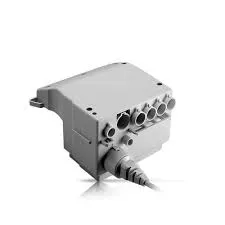Understanding EPR Tape A Comprehensive Guide
EPR tape, short for Ethylene Propylene Rubber tape, is a specialized insulating material that has emerged as a significant component in various electrical and industrial applications. Its unique properties make it particularly valuable in environments where heat, moisture, and chemical exposure are concerns. In this article, we will explore what EPR tape is, its characteristics, applications, and advantages.
What is EPR Tape?
EPR tape is made from a copolymer of ethylene and propylene, which provides excellent elasticity and resilience. This type of tape is typically used as an insulating material for electrical cables and equipment. EPR's molecular structure allows it to maintain flexibility at low temperatures while also being resistant to degradation from heat and UV radiation. Manufacturers often enhance this base material with additives that improve its performance, such as flame retardants or anti-oxidants.
Key Characteristics
EPR tape exhibits several distinctive features that contribute to its widespread use
1. Excellent Insulation One of the primary uses of EPR tape is as an electrical insulator. It has a high dielectric strength, making it suitable for protecting wires and cables against electrical leakage.
2. Chemical Resistance EPR is inherently resistant to various chemicals, including acids and bases. This quality makes EPR tape ideal for use in industrial settings where exposure to harsh substances is common.
3. Temperature Stability EPR can withstand a wide range of temperatures, from -40°C to +90°C (-40°F to +194°F). This temperature resiliency ensures that it can perform effectively in both hot and cold environments, making it an exceptional choice for diverse applications.
4. Moisture Resistance The tape is also resistant to water and humidity, which is crucial for preventing electrical failures in moist or wet conditions.
5. UV Resistance EPR tape can withstand prolonged exposure to ultraviolet light without losing its insulative properties, making it suitable for outdoor applications.
Applications
EPR tape is versatile and widely used across various industries
epr tape

1. Electrical Insulation Electrical utilities and contractors often use EPR tape to wrap electrical cables and components to prevent short circuits and electrical failures.
2. Automotive Industry EPR tape is commonly used in vehicles for insulating electrical wiring and protecting components from environmental factors such as moisture and heat.
3. Industrial Equipment Many manufacturers use EPR tape to shield machinery and equipment from chemical spills or extreme temperatures.
4. Home Appliances In household items, EPR tape serves as a protective layer for wiring to prevent accidents and ensure appliance longevity.
5. Telecommunications EPR is also used in communication cables, where its insulating properties preserve signal quality.
Advantages of EPR Tape
The advantages of EPR tape are notable
- Durability EPR tape is designed to last, providing long-term protection in demanding environments. - Versatility Its ability to perform across various sectors makes it an essential material in many applications.
- Cost-Effectiveness While quality materials can sometimes be more expensive, the longevity and effectiveness of EPR tape can lead to savings in the long run due to reduced maintenance and replacement costs.
- Safety EPR’s flame-retardant properties add a layer of safety, reducing the risk of fires in electrical applications.
Conclusion
EPR tape is an indispensable material in today's electrical and industrial landscape. Its unique combination of properties—insulation, chemical and temperature resistance, moisture-proofing, and durability—makes it an ideal choice for a variety of applications. Whether in the electrical, automotive, or industrial sectors, EPR tape offers reliable performance, ensuring that equipment operates safely and efficiently. As industries continue to evolve, the significance of EPR tape will likely remain paramount, solidifying its role in modern technological advancements.
-
XIANGFAN Rubber Tape-Ultimate Solutions for All Your Insulation NeedsNewsJun.24,2025
-
XIANGFAN Rubber Tape-Protection for Industrial and Residential ApplicationsNewsJun.24,2025
-
XIANGFAN Rubber Tape: Superior Safety and Sealing for Demanding EnvironmentsNewsJun.24,2025
-
XIANGFAN Rubber Tape: Reliable Solutions for Every Electrical ChallengeNewsJun.24,2025
-
XIANGFAN Electrical & Industrial Tape: Powering Reliability Across IndustriesNewsJun.24,2025
-
XIANGFAN Electrical & Industrial Tape: Excellence in Every ApplicationNewsJun.24,2025
